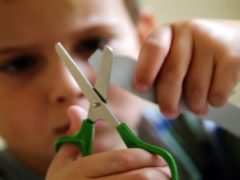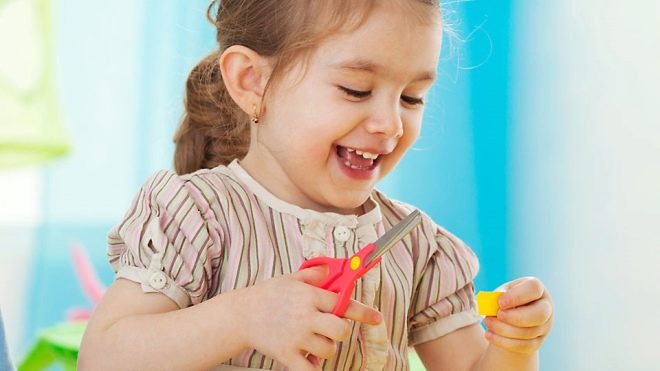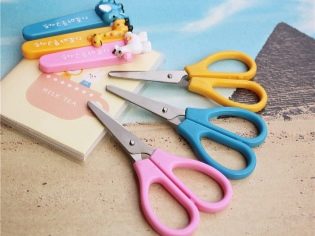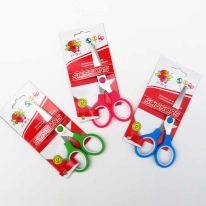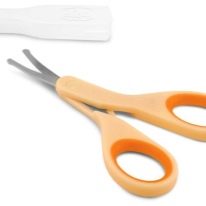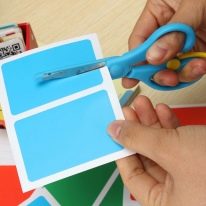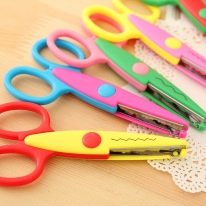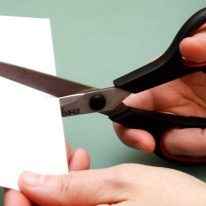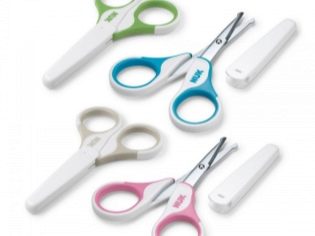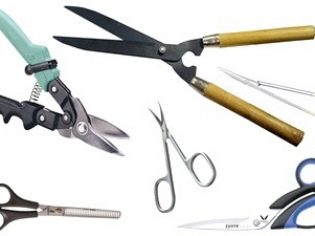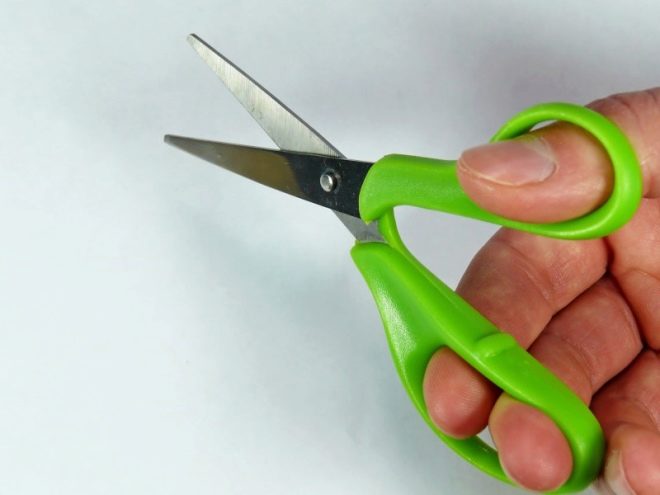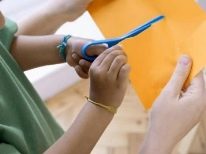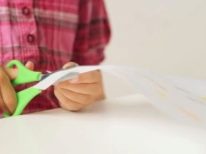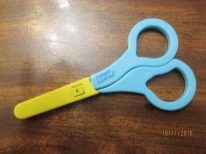Baby scissors: what should they be and how to use them?
Scissors are a useful tool. While the child is in its infancy, the right scissors allow the mother to easily keep the nails on the arms and legs of the crumbs in order. From two years old, the child himself begins to gravitate toward this object, he becomes interested in cutting out of paper, cardboard. But many mothers and fathers look with horror at the child’s attempts to pick up scissors, since childhood they have been taught that this tool is a danger.
There is no reason to deny a child acquaintance with this tool, if the scissors are selected correctly.
Special features
Gone are the days when scissors were indicated by a children's riddle about two ends, two rings and a stud in the middle. Today there are a great many of the most diverse models, and products for babies are displayed in a separate category - children's scissors. They can be used for home creativity, for use in classes in kindergarten, in labor classes in elementary school. The choice of tools for children does not tolerate negligence, because it is about the safety of the child.
The right baby scissors are lightweight, safe, with rounded ends. Not the right choice for a child is a tool with a plastic blade - they are blunt and heavy. It is also worth staying away from products with wide blades, which usually look very cute in children's performance, but they are impractical.
Children's scissors should have a reliable place for attaching the rings to the blades - this is usually the weakest point. As for the rings, it is worth noting that today the choice is very large, there are even tools with an unprecedented shape of rings. And then no one will say in advance whether they will fit the child or not, it all depends on how convenient such rings will “lie” in the child’s hand. And therefore, experts recommend go shopping for a tool with your child, taking with him a piece of paper, cardboard or unwanted fabric so that, without departing from the cash register, the child could try out the future acquisition in action.
Often parents can face a situation where scissors are packed so securely that it is not possible to get them and check them. There are two ways out - either to insist on opening the package and “test drive”, or to deliberately refuse such a purchase, choosing unpacked options.
Important! Both a two-year-old child, and a kindergarten student and a primary school student will have options with not long blades, the length of which does not exceed 12 centimeters, with rings of small size, so that children's fingers can be comfortable in them.
What are the?
Scissors, like any other tool, are of different purposes - there are nail scissors, which are convenient to maintain cleanliness, the desired shape and length of children's marigolds. It is quite another thing - a tool for creativity, for paper or cardboard, for fabric and natural materials. There is among the children's products and a special group of products - scissors for left-handers.
With conventional baby scissors, it will be difficult for a left-handed child to cut something neatly, because in ordinary standard tools the upper blade is always a little to the right than the lower one (this is a kind of lever for the right hand). The cut line with his left hand with such scissors is hidden from the eyes of the young creator, it turns out uneven. Special tools created for children with the prevailing left handle help to cope with the task. They have the blade attached on the contrary, which allows the child to cut without difficulty.
Important! Do not believe advertising, which claims that before you are "universal" scissors - these do not happen. Manufacturers are cunning, calling the usual ordinary "right-handed" scissors universal.
All children's scissors have a certain age classification. Thus, products intended for 3–4 years old are not suitable for children in primary school, and products for 5–8 years old are not always suitable for children under 2 years old. Specialists working in kindergartens, without enthusiasm, belong to the tools intended for the category of 3-4 years, because they mostly have plastic blades that are uncomfortable to cut, they crumple and tear the paper.
Often children themselves prefer scissors, in which it is constructively possible to thread two fingers at once in the same ring, middle and index. They are so comfortable. Educators do not mind such a choice.
Differences from ordinary scissors
Special children's scissors are different from the usual first of all by increased security measures - they have blunt and rounded ends, so that the child is not injured. And they also have a sharpened blade so that the baby does not cut. There are differences in the form of blades and rings, as well as in the weight of the finished product.
Children's scissors are lightweight and shorter when compared with adults. Scissors for adults have a lot of purposes - there are tailoring scissors and medical, for working with paper and scissors for metal. Children's products of such a rich assortment of purpose are not.
Requirements
The most dangerous part of the scissors are the ends. It is they who inflict the most serious injuries to themselves and others. Therefore, from the pointed scissors should be abandoned. The main requirement for children's tools - security. Only safe scissors with rounded ends Suitable for children, and no others. Use the child's pointed scissors gradually, step by step, starting with the 4-5 grade school.
To relieve children's fingers from corns and sores after long work with scissors will help compliance with the requirements for rings - better if they are rubberized. Particular attention should be paid to the width of the blades - too wide blades cut poorly, the young creator will not be able to embody all his creative ideas in paper or cardboard. Such scissors is difficult to cut curly crafts, and nothing can be done about it. Pens decorated with characters of fairy tales and cartoons are very popular with children.
But do not flatter yourself - the more on the rings of jewelry, the less convenient they are to use. And also you should not choose too tight scissors, the child will be difficult to work with them.
If the child is left-handed, you need to buy special scissors. If the child is ambidexter (he copes with food and drawing with two hands equally well), buy him both options - both regular scissors, and for left-handers. He will choose the way he likes to work. It is possible that the use of those and others.
Terms of use
It is important to understand that even safe children's tools can be dangerous if the child is not told and shown how to use them correctly. Even when working with baby scissors, there is a safety precaution that parents should tell children about immediately after buying scissors. Safety when working with baby scissors involves the following simple rules with which the child is introduced in the first place:
- the instrument should always be stored in a dry place, it should not be thrown into the bathroom, doused with water, left on the street, on the balcony with temperature drops and air humidity; if you ignore this requirement, scissors will quickly rust;
- during cutting the child must be focused and very attentive, at the same time it is impossible to cut and watch cartoons, because it can lead to injury
- if the scissors are transferred to another, it is correct to hold them by the closed blades and nothing else;
- they do not walk, run, play or play with scissors in their hands; this can lead to serious injury, even if the instrument is childlike and seemingly safe;
- It is necessary to organize the child’s work space so that he does not drop the scissors on the floor - the tool may break down due to frequent falls.
Teaching a child to work with scissors can Not earlier than the baby turns 2 years old. Some parents prefer to do it closer to 3 years, but everything is rather individual. The child must use the tool just sitting at the table. And the first material with which he should get acquainted, should be paper. Attempts to cut a baby something else should be stopped until a certain (usually six years) age.
The baby should always ask for permission from mom or dad to use the tool and in no case should he be left alone with them. This restriction applies not only to two-year-olds, but also to all children of preschool age. Before training, it is advisable to make sure that the handles of the baby are quite strong to cope with scissors. To do this, you can give him a piece of paper and ask him to tear it into small pieces, and then on another sheet make many holes with a hole punch (all under the supervision of a training adult).
Important! Properly holding a pair of scissors is not a skill with which people are born, this child will have to be taught. The thumb should be directed strictly upwards. In the second ring is placed either the middle finger or the middle and index finger, if the design of the tool implies such a grip.
After the baby learns to take in hand and hold the scissors correctly, show him what ways of cutting exist. For example, you can cut a sheet of paper into stripes. When he masters it, go to simple geometric shapes - a square, a rectangle, a triangle. Remember that the circle and the oval - the most difficult to cut, they are taken as the last. And only after that you can offer chad figurines for cutting.
Practical tasks for teaching children to cut out are given below.
